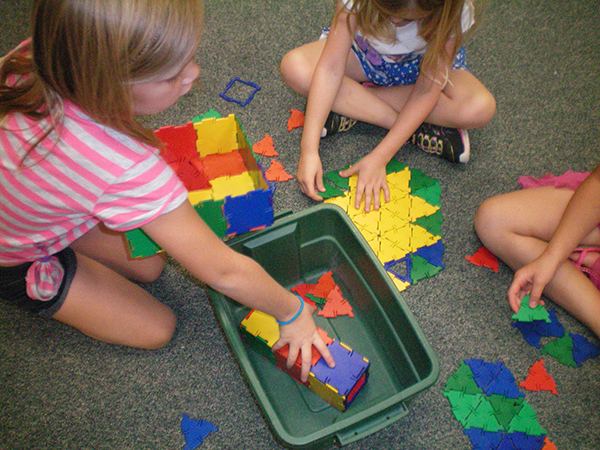Polydron Power!
This article is reproduced with the kind permission of Bridges In Mathematics.
Portland Public School kindergarten teacher Nicki Eybel recently sent us a great question:
My kindergarten students LOVE Polydron sets. They seem like a fairly "limited" material. The students make boxes and fill them with...well, lots. Then they build pyramid roofs and that's all. Do you have any suggestions to scaffold Polydron learning at this time of year? Or, are we on the "right track" in Room 12?
I asked kindergarten specialist Heather Neu to respond. She writes:
I think they are on the right track. The whole point is for students to experiment with them. I have seen students work together to make a huge rectangle. I have seen amazing creations built from cooperation of the whole group. Polydron sets are an exploratory manipulative. Sounds like good things are happening.
Shelly Scheafer, teacher, instructional coach, and author of grade 1 Number Corner, second edition, adds:
I chuckled out loud the first time I read this email. I don't completely understand the fascination young children have for Polydron, but it definitely exists. In my Getting Started Workshops I always use Polydron sets to answer the question of why there needs to be some way to monitor where students have been during Work Places--absent some limits, you would have a group that would choose Polydron every day for days and days. I keep mine with my "inside recess" choice items rather than my math materials just so students can continue to build boxes and fill them up--just what they want to do! Kindergarteners in Room 12 are right on track.
Kindergarten and first grade geometry standards (K.G.5, K.G.6, 1.G.2), are about playing with shapes to make new shapes: exactly what they are doing with Polydron pieces. You can see some of my first grade students' creations below.
My students have enjoyed building boxes for specific objects (think small toys) that I've added to the Polydron sets. The question becomes, "What kind of box would you build as a package for this toy?" With first graders, I've added small items and ten-frame counting mats and posed questions like, "How many (name of object) can this box hold?" or "Can you build a box to hold (number) of (name the object)?" I can see kindergarteners being asked, "Will the box hold more (name of object) or more (name of object)?" Just think of the seeds being planted for future lessons on volume and capacity!
In grade 1, students view pictures of Polydron nets and predict whether the net will fold into a cube or pyramid. They try it. At my school, we build on this idea in second grade by having students make nets as part of their box design when given a STEM challenge to build an insulating box to keep an ice cube or Otter pop frozen for a period of time. Success in these tasks comes from being able to visualise the two-dimensional surface areas of the three-dimensional object. Exploring this concept over and over (starting in kindergarten) is how this understanding develops.
On a personal note, I've used Polydron sets with children through sixth grade. In a gifted program I taught for grades 2-6, Polydron was the most popular free-choice item. For ideas on what children might do with them, do a Google image search for Polydron. The low floor, high ceiling flexibility inherent in this manipulative consistently draws students of all ages and abilities. In this photo my son, then 8 years old, shares one of his creations.

Cynthia Hockman-Chupp, Bridges In Mathematics

